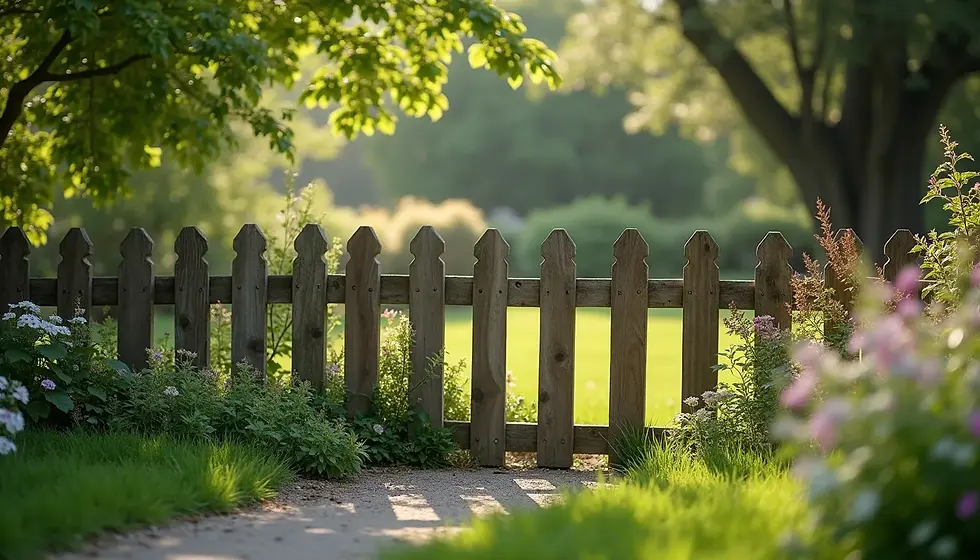How to Tell Fence Is Old: 9 Fast Checks You Can Do!
- Mei-Lin Arora

- Sep 4
- 3 min read
Updated: Sep 13
Buying a house, prepping to sell, or just wondering if your fence is living on borrowed time? Here’s how to decide how to tell fence is old—quickly, confidently, and without yanking every picket. We’ll show you the one-minute scan, material-specific clues, and when repairs stop making sense. 🧰
Old fences don’t usually fail in one big moment—they whisper for years. Your job is to listen.

How to Tell Fence Is Old — The One-Minute Scan
Stand at each corner and look down the line. Then check these high-signal clues:
Leaning or wavy lines. Consistent lean = tired posts or failed footings.
Soft posts at grade. Probe near soil; punky wood means decay is active (see the science of wood rot in the long-standing USDA Forest Products Laboratory Wood Handbook).
Loose rails / fasteners. Nails backing out, split rails, or screws with no bite signal age and moisture cycling.
Gate sag. If you have to lift the latch, posts or hinges are done.
Surface clues. Severe graying, raised grain, and deep checks (wood); chalking and brittleness (vinyl); red rust or white corrosion bloom (metal). For galvanized steel corrosion patterns, see the American Galvanizers Association.
Footing failure. Heaved concrete “donuts,” gaps around posts, or water pooling at bases.
Chain-link slack. Baggy fabric, broken ties, or loose tension bands—maintenance time (component basics at CLFMI).
If you’re deciding boundary lines or privacy, this primer on types of fences covers materials, maintenance, and cost so you pick once and right.

What Age Looks Like by Material
Wood (cedar, pine, redwood).
UV graying is normal; soft posts, split rails, and fungi-looking decay at the soil line scream age. Pressure-treated posts last longer but still fail if crowns hold water. The University of Missouri Extension fencing guide covers long-standing rural and residential fence practices that apply here.
Vinyl.
UV exposure leads to chalking (white residue), brittleness, and hairline cracks near fasteners. Yellowing and warped panels mean it’s been there a while—or cooked by reflected heat.
Chain link.
Look for rust at welds, flaking zinc, and loose fittings. If terminal posts wobble or the bottom tension wire is gone, the system’s past its prime.
Ornamental steel/iron.
Rust at picket-to-rail junctions and hollow-sounding sections (hidden corrosion) indicate advanced age.
Repair or Replace? A Quick Rule of Thumb
Repair if damage is localized (one or two posts, short run of rails, one droopy gate). Re-set posts in new concrete, swap rails/pickets, tighten hardware.
Replace when 25–30% of posts are soft/loose, gates won’t stay aligned, or you’re stacking fixes each season. New materials plus proper drainage beats chasing rot.
Hybrid wins often: new posts + rails, reuse good pickets for now, plan a full replacement in 1–2 years.
If you’re pricing more than a third of the fence in parts and labor, your money is begging to become a new fence.
Choosing a modern look for metal barriers? This style explainer on metal fence flat-top vs sphere shows how caps change safety and vibe.
How to Stretch the Remaining Life (If You’re Not Replacing Yet)
Drainage first. Lower mulch/soil against pickets, crown around posts, and stop sprinklers from wetting wood daily.
Hardware refresh. Swap rusted nails for exterior screws; replace sagging hinges with adjustable ones.
Clean and seal. Wash, let dry, then apply a penetrating stain/sealer (wood) or gentle vinyl cleaner; touch up metal rust with converter + paint.
Re-tension chain-link. New ties, tension wire, and a bottom rail can add years with minimal cost.

FAQ
How to tell fence is old in one sentence?
Check for leaning lines, soft posts at soil level, failing gates, and widespread corrosion/chalking—three or more signs usually mean the fence is near end-of-life.
Can I just replace a few posts?
Yes—if most rails/panels are sound; otherwise you’ll chase failures down the line.
Any way to estimate age with no records?
Severe post decay, vinyl chalking, or widespread steel rust usually means 15+ years outside without major maintenance.
What’s the life expectancy by type?
Wood 10–20 years (care and climate swing it); vinyl and chain-link often longer with basic upkeep; ornamental steel varies with coating quality.
Skunks are better kept out than trapped—this practical answer to can a skunk climb a fence covers height and footing.
Conclusion
The fastest way to decide how to tell fence is old is to scan for structural clues (posts, rails, gates) and material aging (decay, chalking, corrosion). If issues are isolated, repair; if they’re widespread, replacement saves money and headaches. Either way, fix drainage and hardware now—future you will thank you. 🙂



Comments